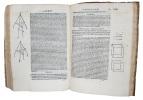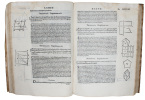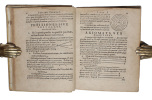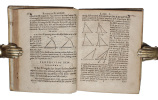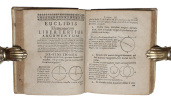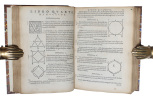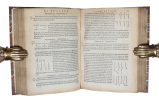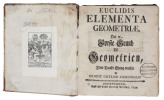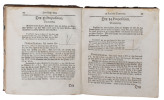9 books for « euclid of alexandria »Edit
-
Century
16th (3)
17th (3)
18th (3)
-
Topics
Alexandria (9)
Mathematics (9)
Translation (1)
Evclide Megarense Philosopho: solo introdvtttore delle Scientie Mathematice" diligentemente Reassettato, et alla integrita ridotto per il degno Professore di tal Scientie Nicolo Tartalea, Brisciano, Secondo le due Tradottioni: e per commune commodo & ... - [FIRST ""EUCLID"" IN THE VERNACULAR BY TARTAGLIA.]
(Colophon: Venice, Venturino Rossenelli, 1543). Folio. (30,5x22 cm.). Contemporary full Italian limp vellum. Remains of ties. Old handwritten title on spine. Upper part of frontcover slightly creased. A few small nicks to hinges at cords. Vellum with brownspots. 242 leaves (2-241 numb. II-CCXXXIX). Misnumbering of leaves in sign. A (10 lvs.), due to the insertion of corrections on f A5. (Collation corresponds to that given by Thomas-Stanford No. 34). Large margins profusely illustrated with diagrams. Upper right corner of title gone with loss of of 3 letters ""NSE"" in MEGARENSE, f A2-A6 with upper right corners and a wormtract-hole in lower margin repaired. A wormtract in lower margin on the next 11 lvs. A1-A6 mounted skillfully on thin opaque parchment-paper. A rather faint dampstain in upper right corner throughout. Last 5 leaves with a small nick in right margin, no loss. Otherwise remarkable clean and printed on good strong paper. On the title a large woodcut device with arms with G.T. (Gabriele Tadino, to whom the work is dedicated). Colophon with large woodcut device with the letters .P.Z.F. and this repeated on verso of last leaf.
Scarce first edition of the first translation of Euclid in any modern language by the famous Niccolo Tartaglia. The translation and Tartaglia's commentaries, strongly accelerated the development of physics and mechanics in the 16th century, as it showed how mathematics could be applied to dynamics and mechanics as well as to architecture, construction and perspective. More than 20 years should elapse before the next language should receive the privilege of displaying Euclid among their goods, this was the French translation published by Pierre Forcadel, Paris 1564. ""When Tartaglia submits that his redaction was made ""secondo le due tradittioni"", there is no question that Campanus - who appears to be heavely favored - and Zamberti are meant. When Campanus has added propositions or premises, Tartaglia has approriately translated them and noted their absence ""nelle seconda tradittione"", while things omitted by Campanus but included by Zamberti receive the reverse treatment"" (John Murdoch in DSB).Niccolo Fontana Tartaglia of Brescia has a great name in the history of mathematics. A cut in the face from a French soldier caused him to stammer and as a consequence of this he was called 'Tartaglia' (the stammerer). He is famous for his solution of third-degree equations which occasioned a long polemic with Cardano about priority. He is also known for ""Tartaglia's Triangle"", later known as ""Pascal's Triangle"", and he is well-known for his Archimedes-edition of 1543 and 1551 with his commentaries.""The most famous source of Greek geometry is the monumental work of Euclid of Alexandria, called the ""Elements"" (around 300 B.C.). No other book of science had a comparable influence on the intellectual development of mankind. It was a treatise of geometry in thirteen books which included all the fundamental results of scientific geometry up to his time. Euclid did not claim for himself any particular discovery, he was merely a compiler. Yet, in view of the systematic arrangement of the subject matter and the exact logical procedure followed, we cannot doubt that he himself provided a large body of specific formulations and specific auxiliary theorems in his deductions. It is no longer possible to pass judgement on the authorship of much of this material"" his book was meant as a textbook of geometry which paid attention to the material, while questions of priority did not enter the discussion."" (Cornelius Lanzos in ""Space through the Ages"").Max Steck III:40 - Thomas-Stanford: 34 - Riccardi Euclideana 1543, 1 - Adams E:992. - Brunet II:1090. (Premiere edition de ce travail estimé). - Graesse II:513.
In geormetriam Euclidis Demonstrationum Libri Sex. In quibus Geometria planorum traditur, & brevis Notis perspicue explicatur. Impensis & sumptibus Authoris. - [FIRST SWEDISH EUCLID-EDITION.]
Uppsala, Eschillus Matthiæ, 1637. Small 4to. Cont. full vellum over wood. Spine ends worn, tears to hinges, but not broken, lower edges of boards with old repairs. Some old ink annotations on boards. Inside frontcover and on title many old owner names, small wholes cut in titel without loss of letters. First ab. 20 leaves with a faint dampstain in upper margin, inkspots on last page. Internally clean. (24),350,(2) pp., numerous geometrical diagrams in the text.
Scarce first edition of the first Swedish edition of Euclid's Elements (Book I-VI) with Gestrinius' commentaries to the axioms and porpositions and with his attempt of a proof of the ""Parallel-axiom"" (The Fifth Postulate). In the preface he discusses the use of plane-geometry in the theories of Aristoteles, Eudoxus, Ptolemy and Kepler. - Gastrinius (1594-1648) became professor of mathematics in Uppsala in 1621 after studies in Greifswald.Collijn (1600-Talet) I:310. - Riccardi p. 436 (1637,2) - Poggendorff I:889. - Not in Max Steck.
Euclide Megarense Philosopho, solo Introduttore delle Scientie Mathematice. Diligentementee Rassettato, et alla integrità ridotto, per il degno professore di tal Scientie Nicolo Tartalea Brisciano (Nicolo Tartaglia). Secondo le due Tradottioni. Con un...
Venetia, Curtio Trojano, 1565. 4to. Bound in a very nice recent hcalf in old style. Raised bands and richly gilt back. 315,(1) leaves (=632 pp). Profusely illustrated with gemetrical diagramss in the text. Printers woodcut-device at end. Small part of lower right corner of title gone, no loss of text. Light browning to first and last leaf. 6 last leaves with a faint dampstain. Very light browning to outher margins. Otherwise a fine clean copy.
Scarce second edition of Tartaglia's very influential translation of all Euclid's 15 Books, as this Italian translation of Euclid was the first translation at all into the vernacular. The translation by Tartaglia was first published 1543 and was founded on the latin edition of Campanus and Zambetti.Niccolo Fontana of Brescia has a great name in the history of mathematics. A cut in the face from a French soldier caused him to stammer and as a consequence of this he was called 'Tartaglia'. He is famous for his solution of third-degree equations which occasioned a long polemic with Cardano about priority. He is also known for ""Tartaglia's Triangle"", later known as ""Pascal's Triangle"", and he is well-known for his Archimedes-edition of 1543 and 1551 with his commentaries.""The most famous source of Greek geometry is the monumental work of Euclid of Alexandria, called the ""Elements"" (around 300 B.C.). No other book of science had a comparable influence on the intellectual development of mankind. It was a treatise of geometry in thirteen books which included all the fundamental results of scientific geometry up to his time. Euclid did not claim for himself any particular discovery, he was merely a compiler. Yet, in view of the systematic arrangement of the subject matter and the exact logical procedure followed, we cannot doubt that he himself provided a large body of specific formulations and specific auxiliary theorems in his deductions. It is no longer possible to pass judgement on the authorship of much of this material"" his book was meant as a textbook of geometry which paid attention to the material, while questions of priority did not enter the discussion."" (Cornelius Lanzos in ""Space through the Ages"").Max Steck III:72 - Thomas-Stanford: 39 - Riccardi Euclideana V:1 - Adams E:993. - Brunet II:1090.
Euclidis Megarensis mathematici clarissimi Elementorum geometricorum libri XV. Cum expositione Theonis in priores XIII à Bartholomæo Zamberto Veneto (= Zamberti) latinitate donata, Campani in omnes, & Hypsiclis Alexandrini in duos postremos. His addie...
Basel, Johannem Hervagium & Bernhardum Brand, 1558. Folio. (30,5x21,5). Bound in 19th century brown hmorocco with 5 raised bands. Light wear to back and corners a bit bumped. (2),587 pp.Numerous wood-cut diagrams and initials throughout. First ab. 20 leaves with different degrees of yellowing and occasional with marginal faint dampstaining. 3 leaves with upper right corners repaired without loss of text. The ""privilege"" at verso of title partly unreadable as a piece of paper is pasted on, some of these letters are faint, just as some letters in ""Basiliae"" on title are weak. Last leaf with colophon and printers large woodcut-device on verso is mounted, but not hiding the wood-cut. The word ""Basiliae"" on last leaf recto, is weak or nearly gone. Overall a large good copy as usually without the foreword by Melanchton. A small rubber-stamp on title: ""Duplum Bibliothecæ V.E."" and in old hand: ""Bibliothecæ Conventij Romani S. Andrea de Fratrij (?)""
Scarce third printing of the so-called Zambert-Campanus Edition of the Elements, all printed by Johann Herwagen in Basel - this edition printed together with his son-in-law Bernhard Brand. The first of the Herwagen prints was the famous Editio Princeps in Greek from 1533, and in 1537 he published a Latin version, which became the first Euclid-editon to contain also Euclids smaller tracts as ""Phenomena""(Spherical geometry), ""Katroptik"" (Mirror-reflexion), ""Optik"" und ""Data""(Geometrical excersises). The 1537- edition was reprinted 1546 and in 1558 (the present).""The most famous source of Greek geometry is the monumental work of Euclid of Alexandria, called the ""Elements"" (around 300 B.C.). No other book of science had a comparable influence on the intellectual development of mankind. It was a treatise of geometry in thirteen books which included all the fundamental results of scientific geometry up to his time. Euclid did not claim for himself any particular discovery, he was merely a compiler. Yet, in view of the systematic arrangement of the subject matter and the exact logical procedure followed, we cannot doubt that he himself provided a large body of specific formulations and specific auxiliary theorems in his deductions. It is no longer possible to pass judgement on the authorship of much of this material"" his book was meant as a textbook of geometry which paid attention to the material, while questions of priority did not enter the discussion."" (Cornelius Lanzos in ""Space through the Ages"").Max Steck III:57 - Thomas-Stanford: 15 - Riccardi 1558/3 - Adams E:976.
"EUCLID (EUKLID) OF ALEXANDRIA. - FIRST DANISH EDITION OF ""EUCLID"".
Reference : 41890
(1744)
Euclidis Elementa Geometriæ, Det er, Første Grund Til Geometrien, I det Danske Sprog oversat af Ernst Gotlieb Ziegenbalg.
Kjøbenhavn, Ernst Henrik Berling, 1744. 4to. Samt. hldrbd. over træ. Ryg lidt slidt Overtrækspapiret på permer med mangler.(12),20,311 pp. samt 5 foldede kobberstukne plancher, i teksten talrige geometriske figurer. De første blade og de 5 plancher med en svag vandskjold. Svag skjold på de sidste ca 20 blade. En del blade med brunplet i øvre margin.4to. Contemporary half calf over wooden boards. Spine a bit worn and lacing some of the paper over boards. Faint damp stain to first leaves, to plates, and to the last ab. 20 leaves. Some leaves with a brown spot to upper margin. (12), 20, 311 pp + 5 folded engraved plates. Numerous geometrical figures in the text.
Første udgave på dansk af Euclids ""Elementer"", omfattende Bog 1-6 og 11-12. J.F. Ramus have allerede nogle år tidligere udgivet Euclid, men disse var mindre lærebøger i uddrag og på latin. Oversættelsen indeholder en lang introduktion af Ramus ""Betænkning om Euclidis Elementer og om deres Oversættelse i det Danske Sprog.""Ziegenbalg var teologisk kandidat, men havde studeret matematik i flere år, både i Jena og i England. Han blev udnævnt til professor i matematik ved Københavns Universitet efter Ramus, og havde i nogle år forinden fungeret som dennes assistent. Hans oversættelse er dedikeret Christian den VI, og i forordet introducerer han den således ""offereres (oversættelsen) Deres Kongelige Majestæt...disse udi det Danske Sprog oversatte Elementa Geometriæ, som ere Hoved=Kilden til alle Mathematiske Videnskaber og have nu i 2000 Aar været i saa stor Estime, at alle de største og erfarne Mathematici have grundet deres Skrifter paa dem og at de til almindelig Nytte og Brug ere bekientgiorte næsten udi alle Europæiske, men ey tilforn i dette Sprog.""First edition of the first Euclid-translation into Danish, comprising Book 1-6 and 11-12. Bound in cont. hcalf. Rebacked in old style. A good copy. - Riccardi, Bibl. Euclideana, Parte 4, p. 47. - Bibl. Danica IV:96.
Euclidis elementorum sex libri priores. Magnam partem novis demonstrationibus adornati. Opera & Studio Henrici Coetsii.
Lugdunum Batavorum (Leiden), Danielem à Gaesbeek, 1691. Small8vo. Contemp. full vellum. Spine gone and frontcover detached. Some soiling to covers. Wood-cut printers device on titlepage. (24),468 pp. and many diagrams in the text. A few scattered brownspots and a few quires with light browning.
First edition of Heinrich Coetsius' translation of the six first books of Euclid.Riccardi 1691, 7 - Max Steck p. 109, 1691.
De Sex Första jämte Ellofte och Tolfte Böckerna af Euclidis Elementa, eller grundeliga Indledning til geometrien, til Riksens Ungdoms Tjenst opå Svenska Språket utgifna af Mårten Stroemer.
Upsala, Johan Edman, 1774. Lille 8vo. Samtidigt hldrbd. med ophøjede binf på ryggen. Rygtitel. Ryg noget slidt, mest ved kapitæler. (18),429,(1) pp., talrige textfigurer. Brugsspor. Et bladhjørne bortrevet. Nogle samtidige notater og tilskrifter.
De første 6 bøger blev oversat for første gang på svensk i 1744 (også af Mårten Stroemer), mens udgaven her er den første svenske oversættelse, som også omfatter 11. og 12. Bog.Riccardi: 1774-2 - Steck: V29.
Euclides Elemente, für den gegenwärtigen Zustand der Mathematik bearbeitet, erweiter und fortgesetzt. Erste Abtheilung (alles ersch. -Book 1-6).
Berlin, Matzdorff, 1791. Small 8vo. Contemp. hcalf. Gilt spine. Titlelabel with gilt lettering. Stamps on title-page. 402 pp., 3 folded engraved plates.
Contains extensive commentaries to the first 6 Books.
Euclidis Elementorum libri XV. Una cum scholiis antiqvis a Federico Commandino Urbinate in latinum conuersi. Ac nuper a multis mendis quibus antea scatebat vendicati....
Pisavri (Pesaro), Typis Flaminij Concordiæ, 1619. Folio. Contemp. hcalf. Fronthinge nearly broken, but still holding. Titlepage in red a. black. (8) of 10 leaves, lacking first leaf of the foreword and last leaf of Index. Text complete. 255 leaves with many figures in the text. First 16 leaves with some browning and foxing in lower right corners. 5 leaves mended, no loss of text and 8 with smaller repairs, no loss. A few annotations in margins in old hand.
Scarce second (expanded) edition of Federico Commandino's importent translation of the Elements. Commandino's first translation was published in 1572, and this translation was made use of by subsequent editors for centuries. The first Italian translation was also done from the Latin text of Commandino. - Riccardi 1619,2. - Max Steck: IV 19.
 Write to the booksellers
Write to the booksellers